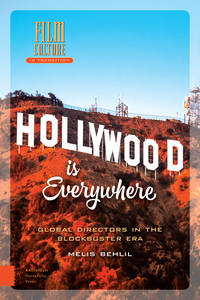 Melis Behlil, associate professor at Kadir Has University in Istanbul, takes it upon herself to interrogate the definition of Hollywood, with the perspective and focus on global directors in the twentieth century: “If it was difficult to define Hollywood in the times of Ford or Forman, it became even more challenging in the final decades of the twentieth century, when media industries underwent major changes, particularly in terms of ownership and organization” (27). In other words, in this book, Behlil illustrates the transnationality Hollywood has achieved over time and development.
Melis Behlil, associate professor at Kadir Has University in Istanbul, takes it upon herself to interrogate the definition of Hollywood, with the perspective and focus on global directors in the twentieth century: “If it was difficult to define Hollywood in the times of Ford or Forman, it became even more challenging in the final decades of the twentieth century, when media industries underwent major changes, particularly in terms of ownership and organization” (27). In other words, in this book, Behlil illustrates the transnationality Hollywood has achieved over time and development.
The first part of her book unfolds analytically with a definition of New Hollywood, which she dates as beginning in the mid-1970s; she rightfully points out that this period is referred to by different names, like “Hollywood Renaissance” or “Blockbuster and Corporate Hollywood.” Hereafter, she divides the book into many subcategories, including: transnationalization, Hollywood as a brand, and, lastly, globalization. With this array of topics to discuss, Behlil’s work is commendable; she manages to confine the vastness of Hollywood into one single book.
Regarding transnationalization of Hollywood, Behlil argues that Hollywood is transnational and thus global because of many reasons, one of which being the purchasing of 20th Century Fox by the Australian Rupert Murdoch in 1985; likewise, MCA, which is linked to Universal Studios, being purchased by the Japanese Matsushita in 1990. These changes, with regards to ownership, are among some of the reasons that Hollywood became transnational from the 1970s and onward. However, Murdoch and Matsushita are but two examples – in an entire book filled with evidence – of why Behlil and many others believe Hollywood is ubiquitous.
Behlil proves Hollywood’s non-Americanism by underlining that Hollywood as a brand enables audiences around the world to expect a certain standard, which can be measured in, for example, great technical skill, high production values, captivating narratives, and emotional yet gratifying happy endings – thus always ensuring a universal approach. She further explains that despite moviemaking being such a collaborative medium, where there are various creative inputs involved and not just one credible source of ownership, it is still expected that the different brands join forces and be represented as one single brand, namely Hollywood: “. . . [B]y the 1990’s, it belong[ed] mainly to global markets and overseas investors, and because so-called ‘American cinema’ is the brand name that sells best in those markets and for those investors, that’s what it says on the label’” (35). This could also explain why it is easier for people to associate Hollywood with one nationality (American) instead of listing out all the different nationalities that operate behind the Hollywood brand.
In the chapter on globalization, Behlil makes it very clear that one should not question why such a broad subject as globalization is narrowed so drastically in her book. She clarifies it as intentional. She explains that because the book is about cinema, she will focus only on some of the relevant theories and approaches related to globalization. Thus, she briefly touches upon Anthony Giddens’s theories, finishing the chapter with a focus on critique of globalization; in what I take to be a fair attempt at giving her main argument depth and perspective.
The second part of the book shifts its focus from theories and definitions to history, through which global directors are introduced. The second part is perhaps where the book gets really interesting. Behlil manages to name such a vast number of directors, producers, and celebrities that one starts questioning whether the book is an appendix for everyone working in, talking with, or related to Hollywood from the mid-1970s until 2005.
Behlil mentions how it has taken her a decade and a half to finish this product, which is understandable. Mentioned in this book is an overwhelming number of foreign directors, producers, scholars and their essays, theories, and development of franchises; and on top of that, many of the people’s origins, nationalities, and citizenships all gathered in this one book. In a lot of ways, this book is meant to acknowledge the vast part of Hollywood that goes unmentioned but has been and is nevertheless very important and influential: “Likewise, while Hollywood is everywhere and dominates the global film culture, alternatives remain, and even thrive. For better or for worse, cheaper digital technologies now allow anyone to make a film if they so desire” (130). This final quote is a short part of Behlil’s conclusion, which I read as an eloquent way of saying that Hollywood has never truly been exclusive, however it has developed to become far more inclusive over the years.
Author Biography
Zulaika Popal is a twenty-year-old undergraduate English student at Aarhus University, Denmark. She speaks five languages, listens to an array of music–everything from The Smiths to BTS–is steadily expanding her (watched) movie repertoire, and is an avid lover of all things 80s.
Book Details
Hollywood Is Everywhere, Melis Behlil, (2016)
Amsterdam: Amsterdam University Press, 202pp., ISBN: 9789089647399 (hbk), $99.00



































